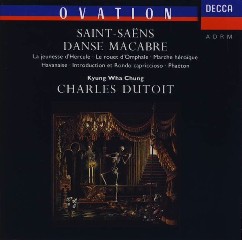Camille Saint-Saens – Danse Macabre & Symphonic Poems etc… (1991)
Camille Saint-Saens – Danse Macabre & Symphonic Poems etc… (1991)

1.Danse macabre, symphonic poem in G minor, Op. 40 2. Pháeton Le Rouet d'Omphale, symphonic poem in A major, Op. 31 3. Le rouet d'Omphale Introduction and Rondo Capriccioso, for violin & orchestra in A minor, Op. 28 4. Introduction et Rondo capriccio Havanaise, in E major for violin & piano (or orchestra), Op. 83 5. Havanaise La jeunesse d'Hercule, symphonic poem in E flat major, Op. 50 6. La Jeunesse d'Hercule Marche héroïque, for orchestra in E flat major, Op. 34 7. Marche héroique, for orchestra in E flat major, Op. 34 Royal Philharmonic Orchestra (3, 4, 5, 7) London Philharmonia Orchestra (1, 2, 6) Kyung Wha Chung – violin (3, 4) Charles Dutoit - conductor
This Decca compilation joins together symphonic poems by the French composer Camille Saint-Saens from the 1870s together with two of his well-known virtuosic violin & orchestra works. The performance is absolutely excellent - very sensitive and refined.
Dutoit and the Philharmonia cover the orchestral works, which are from earlier on in Saint-Saens' careers. The "Danse macabre" is the best-known piece but other works, such as "Phaeton", "The Wheel of Omphale" and the lengthy "Youth of Hercules" also have a reputation. Dutoit included a lesser-known "Marche heroique" in the package as well, a work St-Saens wrote for a friend killed in the 1870 war with Germany. The always excellent Kyung-Wha Chung is also featured in two hair-raisingly difficult pieces for violin & orchestra. While there is some patchy playing in "Hercules" and the last note of "Omphale" is flubbed, these occasional lapses shouldn't detract from a very fine, effective interpretation of these highly entertaining and often beautiful works.
In general, I'd say that this is the disc to get if you wish to introduce yourself to the work of St-Saens. What the other reviewers haven't highlighted is this CDs absolutely outstanding sonics. Precise colors, warmth and fine detail combine into disc at an audio demo level. ---jt52, amazon.com
Composed in 1874 and published in 1875, Danse macabre is the third of Saint-Saëns' four orchestral tone poems and is easily his most popular work in that medium. In his Le carnaval des animaux (The Carnival of the Animals), composed in 1886, Saint-Saëns parodies the Danse macabre, as well as works by other composers.
The title of Danse macabre is usually translated as Dance of Death, but Ghoulish Dance or Dance of Grim Humor might better communicate the character of the piece. Saint-Saëns did not originally write the Danse macabre as a work for orchestra. It was first a song for voice and piano that the composer later transcribed and modified for orchestra. A few lines from the song's text will aid in understanding the symphonic poem: "Death at midnight plays a dance-tune/Zig, zig, zig on his violin....Through the gloom, white skeletons pass/Running and leaping in their shrouds....The bones of the dancers are heard to crack." Once the cock crows, signaling the approach of morning, the fun ends. It is possible that this is the first instance of Death being portrayed as a violinist, an instrument generally associated with the devil.
After the orchestra strikes midnight, depicted by horns and pizzicato strings, the violin soloist plays as if he/she is tuning his/her instrument before a solo flute performs a bouncy melody, which is answered by the strings. The violin soloist then enters with a lilting waltz tune, played twice and answered first by a brief return of the flute theme, with added percussion, and then the entire orchestra with the waltz theme. The piece thus far has behaved like an exposition, presenting the principal material, while what follows consists of variations on that material. Xylophones playing the flute melody depict skeletons dancing just before a fugal presentation of the waltz begins. A new melody in the woodwinds is based on the Dies irae, a chant melody setting the text of the Judgment Day and often invoked by Romantic-era composers when the subject is death. Eventually, both the flute and waltz tune sound at once in the entire orchestra, just before the violin again begins "tuning." After a huge reprise of the combined melodies, a "cock crow" sounds in the oboe and rapid scales depict the scurrying off of the creatures of the night. --- John Palmer, Rovi
download (mp3 @320 kbs):
yandex 4shared mega mediafire cloudmailru uplea ge.tt








